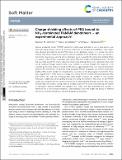| dc.contributor.author | Johnston, Brandon M | |
| dc.contributor.author | Grodzinsky, Alan J | |
| dc.contributor.author | Hammond, Paula T | |
| dc.date.accessioned | 2024-09-20T16:34:40Z | |
| dc.date.available | 2024-09-20T16:34:40Z | |
| dc.date.issued | 2023 | |
| dc.identifier.uri | https://hdl.handle.net/1721.1/156916 | |
| dc.description.abstract | Cationic poly(amido amine) (PAMAM) dendrimers exhibit great potential for use in drug delivery, but their high charge density leads to an inherent cytotoxicity. To increase biocompatibility, many studies have attached poly(ethylene glycol) (PEG) chains to the dendrimer surface. It is unclear how these tethered PEG chains influence the physicochemical properties of the dendrimer. Here, we develop a fluorescence-based assay utilizing anionic biological tissue to quantify the electrostatic binding affinity of a library of PEG–PAMAM conjugates with various PEG chain lengths and grafting densities. We find that covalently bound PEG chains reduce the electrostatic binding affinity more significantly than what can be achieved through covalent bonds only. Contrary to previous thought, this reduction is not explained by the steric hindrance effects of PEG chains, suggesting that other, non-covalent interactions between PEG and PAMAM are present. Using acetylated PAMAM conjugates, we convert electrostatic binding affinity to the number of charged amines accessible to the physiological environment. These data, coupled with 1H-NMR, allows us to study more closely the non-covalent interactions between PEG and PAMAM. We find that increasing PEG chain length increases the number of non-covalent interactions. Additionally, at low grafting densities, increasing the number of PEG chains on the PAMAM surface also increases the non-covalent interactions. At higher grafting densities, however, PEG chains sterically repel one another, forcing chains to elongate away from the surface and reducing the number of interactions between PAMAM and individual PEG chains. The data presented here provides a framework for a more precise mechanistic understanding of how the length and density of tethered PEG chains on PAMAM dendrimers influence drug delivery properties. | en_US |
| dc.language.iso | en | |
| dc.publisher | Royal Society of Chemistry | en_US |
| dc.relation.isversionof | 10.1039/d2sm01698b | en_US |
| dc.rights | Creative Commons Attribution | en_US |
| dc.rights.uri | https://creativecommons.org/licenses/by/3.0/ | en_US |
| dc.source | Royal Society of Chemistry | en_US |
| dc.title | Charge shielding effects of PEG bound to NH2-terminated PAMAM dendrimers – an experimental approach | en_US |
| dc.type | Article | en_US |
| dc.identifier.citation | Soft Matter, 2023,19, 3033-3046 | en_US |
| dc.contributor.department | Massachusetts Institute of Technology. Department of Chemical Engineering | |
| dc.contributor.department | Koch Institute for Integrative Cancer Research at MIT | |
| dc.contributor.department | Massachusetts Institute of Technology. Department of Biological Engineering | |
| dc.contributor.department | Massachusetts Institute of Technology. Department of Electrical Engineering and Computer Science | |
| dc.contributor.department | Massachusetts Institute of Technology. Department of Mechanical Engineering | |
| dc.relation.journal | Soft Matter | en_US |
| dc.eprint.version | Final published version | en_US |
| dc.type.uri | http://purl.org/eprint/type/JournalArticle | en_US |
| eprint.status | http://purl.org/eprint/status/PeerReviewed | en_US |
| dc.date.updated | 2024-09-20T16:13:59Z | |
| dspace.orderedauthors | Johnston, BM; Grodzinsky, AJ; Hammond, PT | en_US |
| dspace.date.submission | 2024-09-20T16:14:01Z | |
| mit.journal.volume | 19 | en_US |
| mit.journal.issue | 16 | en_US |
| mit.license | PUBLISHER_CC | |
| mit.metadata.status | Authority Work and Publication Information Needed | en_US |
